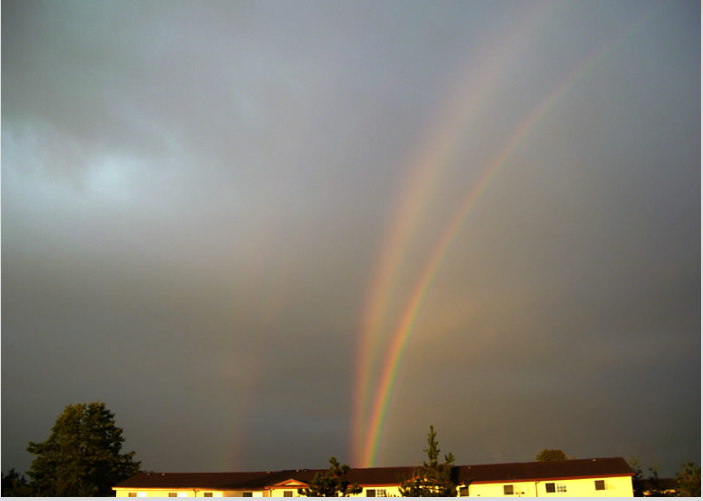Reflection bows and a not quite calm sea
Reflection Bows and a Not Quite Calm Sea
Have you ever witnessed the mesmerizing beauty of a rainbow? It's a magical sight that fills us with awe and wonder. But what if I told you that there can be more to a rainbow than meets the eye? In this article, we will explore the fascinating phenomenon of reflection bows and how they can be observed in the presence of a not quite calm sea.
Imagine this: you're standing on the coast, gazing out at the sea as the sun begins to set. Suddenly, a rainbow appears in the sky, stretching across the horizon. But wait, there's more! As you continue to watch, another rainbow forms, parallel to the first one. And then, something truly extraordinary happens - both rainbows split, giving rise to four distinct bows. This remarkable event was captured by photographer Jay Landry near Oak Harbor, Washington State, USA on August 25, 2007.
Now, let's delve deeper into the science behind these reflection bows. The primary rainbow, which is the brighter and more prominent one, is formed in the usual way. Sunlight enters raindrops in the atmosphere, undergoes internal reflection and refraction, and then exits the raindrop, creating a beautiful display of colors. However, the broad bow to the left of the primary rainbow is not your typical rainbow. It is what we call a reflection bow.
To understand how a reflection bow forms, we need to consider the role of the sea in this phenomenon. In this particular case, the low sun was reflecting off the sea behind the photographer and about four miles away to the west. The reflected rays of sunlight traveled upwards, creating another rainbow centered on a specific point above the horizon called the anthelic point. This point is at the same altitude as the sun. Thus, we have a reflection bow that accompanies the primary rainbow.
But wait, there's still more to the story! Just as the primary rainbow has a secondary counterpart, the reflection bow also has its own secondary bow. This secondary reflection bow is formed in the same manner as the primary one. The reflected sunlight from the sea creates a second rainbow centered on the anthelic point, resulting in a beautiful display of colors.
Now, let's take a closer look at the sea itself. If you observe the reflection bows closely, you'll notice that they appear slightly blurred. This blurring is a result of the sea not being completely calm. The undulations and wave movements on the surface of the water cause the reflection bows to be slightly distorted. Interestingly, the blurring effect is more pronounced in the vertical direction than in the horizontal direction.
To summarize the key points about reflection bows and a not quite calm sea:
- Reflection bows are additional rainbows that accompany the primary and secondary rainbows.
- They are formed when sunlight is reflected off a body of water, such as the sea, and creates a separate rainbow centered on the anthelic point.
- The reflection bows can split, resulting in four distinct bows.
- The sea needs to be slightly turbulent for the reflection bows to appear blurred.
- The blurring effect is more noticeable in the vertical direction due to wave undulations.
In conclusion, witnessing reflection bows and a not quite calm sea is a truly remarkable experience. It reminds us of the intricate beauty of nature and the many wonders that can be found in our surroundings. So, the next time you find yourself near a body of water during sunset, keep an eye out for these extraordinary reflection bows that add an extra touch of magic to the already enchanting sight of a rainbow.

Reflected bows and a not quite calm sea.
Imaged by Jay Landry at Oak Harbor, Washington State, USA near to sunset on August 25, 2007. His son Eric first noticed the rainbow.
"It started as a single rainbow, then a secondary appeared. then both bows split forming four bows."
The broad bow to the left of the bright primary is a reflection bow.
The low sun was reflected off the sea behind the photographer and four miles away to the west. The reflected rays travelled upwards to form another rainbow centered on a point, the anthelic point, above the horizon at the same altitude as the sun.
The secondary reflection bow was formed in the same way.
'Ordinary' bows are centered on the antisolar point beneath the horizon. At sunset the antisolar and anthelic points, and their rainbows, merge.
The sea was evidently not completely calm because the reflection bows are slightly blurred. The wave undulations have blurred them in the vertical more than the horizontal direction.
More reflection bows 1,2,3,4.

Note: this article has been automatically converted from the old site and may not appear as intended. You can find the original article here.
Reference Atmospheric Optics
If you use any of the definitions, information, or data presented on Atmospheric Optics, please copy the link or reference below to properly credit us as the reference source. Thank you!
-
<a href="https://atoptics.co.uk/blog/reflection-bows-and-a-not-quite-calm-sea/">Reflection bows and a not quite calm sea</a>
-
"Reflection bows and a not quite calm sea". Atmospheric Optics. Accessed on December 26, 2024. https://atoptics.co.uk/blog/reflection-bows-and-a-not-quite-calm-sea/.
-
"Reflection bows and a not quite calm sea". Atmospheric Optics, https://atoptics.co.uk/blog/reflection-bows-and-a-not-quite-calm-sea/. Accessed 26 December, 2024
-
Reflection bows and a not quite calm sea. Atmospheric Optics. Retrieved from https://atoptics.co.uk/blog/reflection-bows-and-a-not-quite-calm-sea/.